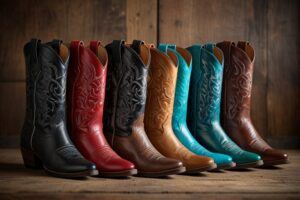
Once upon a time in the dusty trails and open plains of the American West, cowboy boots claimed their turf as a rugged essential. Originally crafted for cowboys in the 19th century, these tough boots were about protection, durability, and a good grip on the stirrups. Women joined the cowboy boot scene a little later, but they’ve since carved out their own space in boot history. As ranching communities expanded and women took on more active roles, it became natural for them to adopt the same functional footwear that had long served their male counterparts.
With fashion always on the move, cowboy boots for women have undergone some stylish transformations. The shift kicked off in the 20th century when ladies decided these boots had to be more than a utilitarian item. Suddenly, design tweaks like pointed toes, intricate stitching, and colorful leathers came into play, turning them into a fashion must-have.
Let’s talk about iconic styles that have stood the test of time. Think about the classic Western boots with their tall shafts and fancy stitching or the combat-ready Ropers with their short, no-nonsense cut. These designs, influenced by cultural milestones like the cowgirl icons of Hollywood Westerns, have made cowboy boots an enduring fashion staple. From Dale Evans to modern country singers, these icons have consistently redefined what it means to wear cowboy boots with attitude and grace.
The cowboy boot isn’t just leather and soles; it’s a piece of cultural history. Its evolution mirrors societal changes, such as women stepping into roles traditionally held by men. Every scuff, stain, and stitch tells a tale of personal expression and rebellion – making them more than just footwear but a badge of identity. Whether riding horses, performing on stage, or making a fashion statement downtown, women have embraced cowboy boots as symbols of empowerment and authenticity.
Styles and Types of Cowboy Boots for Women

Cowboy boots today? They’re as much about personal style as they are about function. With a lineup that includes classic Western, versatile Roper, and modern Fashion-forward designs, there’s a boot for every vibe. Western boots typically feature tall shafts and are adorned with detailed stitching, perfect if you’re channeling that vintage cowgirl spirit. If you’re all about comfort, Ropers are your go-to; with shorter, more practical designs, they’re a staple for both ranch visits and city commutes. Some modern takes even feature ankle-cut cowboy boots, which pair perfectly with skinny jeans, skirts, or even dresses.
Then there’s the material game. Leather remains iconic, of course, offering durability and a classic feel. But, for a twist, some dive into exotic leathers like snakeskin or ostrich for an eye-catching statement. And, don’t forget embellishments – studs, embroidery, and inlays add uniqueness that turns heads everywhere. It’s not just about the boot anymore; it’s a statement piece. In recent years, designers have experimented with mixed materials, blending suede and leather or adding metallic finishes to create bolder, more urban styles.
Each season brings new trends. Winter might call for boots with shearling linings for warmth, while summer might call for lighter leathers or vibrant colors. Staying tuned to seasonal trends is key to rocking cowboy boots in style and comfort all year round. Some fashionistas even opt for white or pastel cowboy boots in spring to freshen up their wardrobe while staying true to their Western roots.
Choosing the right cowboy boots isn’t just a matter of picking your favorite color or design. Consider the occasion. A pair meant for a music festival might not suit a formal gathering, but there are designs out there for every event, allowing you to express your unique style without compromise. Many women now own more than one pair—practical pairs for daily use and more ornate ones for special occasions or fashion statements.
How to Select the Perfect Cowboy Boots for Comfort and Fit

Picking the perfect pair of cowboy boots isn’t just about style; fit and comfort play crucial roles too. Before hitting your favorite store or browsing online, understanding a bit about your foot anatomy is important. Cowboy boots should fit snugly around the foot, offering support without being too tight.
Shopping for boots in-store is ideal because you can try them on and get a feel for the fit and comfort on the spot. Pay attention to the arch support, as a good arch can prevent sore feet after a long day. If you’re venturing online for your boots shopping, check customer reviews and size charts (they can be lifesavers!). Changes in brands or even within the same brand’s line can mean different fits. Try to wear the same kind of socks you’ll normally wear with your boots when trying them on for a more accurate fit.
Common pitfalls while choosing boots often involve getting the size wrong. Remember, a good fit means your toes shouldn’t feel cramped, and the heel should slip just a bit on the first wear – it’ll soon mold to your foot. If you’re in between sizes, consider choosing the larger size and adding insoles for added comfort and support.
It’s easy to neglect the importance of the heel design, but it greatly affects comfort. High heels can offer a stylish lift but might not be comfortable for all-day wear, while lower heels generally provide more stability. Consider the activities you’ll be doing, and choose accordingly. Walking bumpy fields might need different footwear than dancing the night away. Riding heels (usually over 2 inches) are best for horseback riding, while walking heels (under 1.5 inches) offer more everyday practicality.
When done right, a good pair of cowboy boots will feel like a natural extension of your feet, serving both fashion and function effortlesslyUltimately, your cowboy boots should empower your stride, whether you’re walking into a boardroom, a bar, or a barn.
Caring for Your Cowboy Boots: Maintenance Tips for Longevity

Keeping your cowboy boots in top shape requires a bit of love and attention. Proper care prolongs their life and keeps them looking as good as the day you first wore them.
Start with regular cleaning. Dust and dirt can degrade the material over time, so give your boots a good wipe down after wearing. For leather boots, use a soft brush or cloth to remove loose dirt, then apply a leather cleaner to maintain that fresh look. If your boots get muddy, let the mud dry before brushing it off—wet scrubbing can damage the leather grain.
Conditioning is key, especially for leather. A quality leather conditioner keeps the material supple and nourished, preventing cracks and prolonging the boot’s natural luster. It’s best to condition them every few months, or more often if they’re exposed to harsh weather conditions. Applying a waterproofing spray can also help protect against rain and snow, especially if you wear your boots outdoors frequently.
Storing your boots properly can make a big difference. Keep them in a cool, dry place away from direct sunlight, which can cause fading and drying. Using boot trees (or even rolled-up newspaper) helps maintain their shape between wears, avoiding unsightly creases. Avoid storing your boots near heat sources like radiators, as extreme temperatures can warp the leather or dry it out too quickly.
Sometimes, despite the best care, boots need a little extra help. Scuffs and scratches are practically inevitable. Luckily, most can be buffed out with the right polish or colored cream. For more severe damage, professional repair services can work wonders. Getting your boots resoled when the treads wear out can breathe new life into them without compromising the overall shape and fit.
Finally, consider using eco-friendly products for maintaining your boots. Many cleaners and conditioners now offer natural ingredients that are just as effective without harming the environment. Being gentle on your boots and the planet? That’s a win-win. With just a bit of regular maintenance, your boots can last for decades, becoming a beloved part of your wardrobe’s story.
